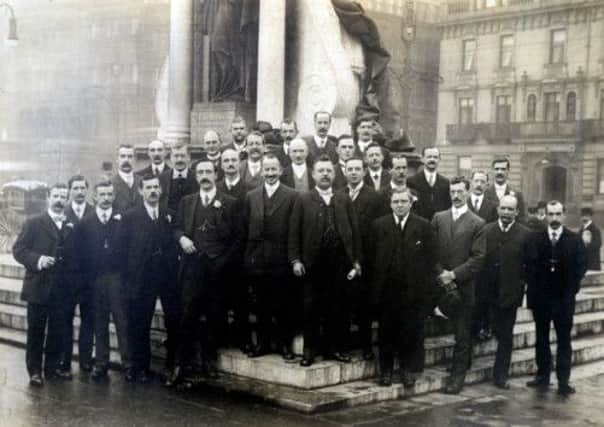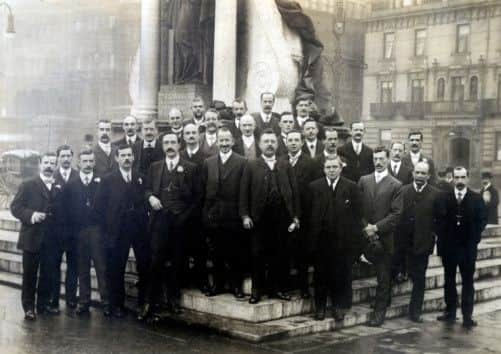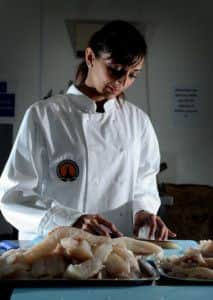Guardians of a frying trade


THERE’S an unmistakable aroma in the air, of one of each with plenty of salt and vinegar, but no fish and chip shop to be found.
Here, in the unlikely setting of a quiet, mostly residential street in the unassuming Leeds suburb of Meanwood, is the spiritual home of Britain’s favourite dish. The smell redolent of a million Friday night suppers is wafting from the huge extractor chimney at the rear of the headquarters of the National Federation of Fish Friers, founded 100 years ago this autumn.
Advertisement
Hide AdAdvertisement
Hide AdThis is Fish and Chip Central, the hub of a £1.2bn trade that serves 382 million portions every year, enough for six each for every man, woman and child in the country, a place where the optimum thickness of a chip is pondered and analysed, regional preferences for rippled or smooth batter discussed, and secret recipes occasionally disclosed.


The federation is custodian, cheerleader and campaigner for the national dish, proud of its history that reaches back to the cold November of 1913 and the stern-looking group of Edwardian friers with moustaches and wing collars who banded together in Manchester to speak up for their trade.
The photograph of them taken that day still hangs on the boardroom wall, and the federation returned to Manchester for its centenary dinner, opting for lamb, since no hotel chef would dare to chance his arm and cook fish and chips for the experts, even though most of them happily dine on the meals they serve up all day, every day, and are noted for sampling other shops’ offerings on their days off.
The inheritors of the founders’ heritage are busy in the training kitchens just across the corridor from the boardroom, chipping, battering and frying for hours at a stretch, giving this corner of Meanwood its characteristic tang in the air.
Advertisement
Hide AdAdvertisement
Hide AdThese are the trainees learning the trade, under the watchful eyes of experienced friers, who not only show them the right way, but the wrong way as well, the consequences of overfrying or undercooking, of batter that is too thin or too thick.


Some are from fish-frying dynasties, learning best practice before taking over the family shop, others are seeking a new direction. As the economic downturn bit, the federation saw an influx from financial services, the building trade and the armed forces, people planning on putting redundancy settlements into their own shop.
The global reach of fish and chips is plain here, with students coming from Australia, Canada and Singapore. Recently, there has been a steady stream from France, as the nostalgia of expats for a taste of home created a demand.
They are all joining a trade which remains in good health, its 10,500 shops – the vast majority of them independently-owned – serving up what is still Britain’s takeaway of preference, despite the onslaught of burgers, pizza and fried chicken.
Advertisement
Hide AdAdvertisement
Hide AdThat trade grew with the industrialisation of Britain, and the long-ago move across the Pennines from Manchester of its spiritual home – in Leeds for decades and Meanwood since 1993 – entirely fitting, because the story of fish and chips is inextricably bound up with the social and industrial history of Yorkshire. Demand for fish led to the expansion of the east coast fishing fleet during the latter part of the 19th-century, and helped the railways prosper as well, as they carried the catch to the great industrial centres of the West Riding.
An unbroken link to that Victorian age of mills and factories remains in the form of The Oldest Fish and Chip Shop in the World, at Yeadon, near Leeds, where they have been ‘frying tonight’ without a break since 1865.
But this is firmly a 21st-century trade in its federation’s 100th year. There’s a smartphone app to locate a chippie near you, its eight-issue-a-year Fish Friers Review – going strong since first being published in 1925 – is passionate about the sustainable sourcing of fish, and the federation has been vigorous in its lobbying of the Government to fend off suggestions that fish and chips bears any blame for Britain’s growing obesity problem.
Which is why there has been much debate about the ultimate thickness of a chip in the training kitchens, and lots of space devoted to the question of the healthiest frying options and use of salt in the pages of The Fish Friers Review.
Advertisement
Hide AdAdvertisement
Hide AdDenise Dodd, general secretary of the federation for the past three-and-a-half years after running a fish and chip business in Guiseley, said: “We’ve always believed a thicker chip will produce a lower fat product, and it does, but we believe there’s an ultimate level. If you go too thick, you can actually increase it. We fried off samples of different thicknesses for the same length of time, and then we sent them off for analysis, so there is quite a science involved.”
There are other strategies in place to boost the health credentials of fish and chips, like encouraging shops to use salt shakers that have fewer holes.
But it’s a fact that customers will keep on shaking until they have as much salt as they want. That’s part of the fish and chips tradition, and there’s no greater repository of the sometimes arcane customs and preferences surrounding this most iconic of British meals, including its regional variations, than the federation.
“How we have our batter is a big one,” said Denise. “In Yorkshire, we like a crispier batter and we like it rippled. In some areas, they wouldn’t dream of doing it that way, the batter’s got to be smooth and quite soft.”
Advertisement
Hide AdAdvertisement
Hide AdThere are the oddities, too. There’s been a sighting of garlic sauce in Sunderland, some suspiciously stringy-looked chips in London, and mystification in the Midlands at a request for a breadcake.
“Your mushy peas are different,” added Denise. “You can have them the Lancashire way or the Yorkshire way. The Lancashire way, they do still resemble a pea. The Yorkshire way is much smoother. And the crust on the pies varies from region to region. Some will only do shortcrust pastry, but for others it has to be flaky pastry. Some regions will even do steamed suet puddings, which I’ve never heard of in Yorkshire.”
Denise limits herself to fish and chips once a week – a notable act of willpower when they are being cooked downstairs from her office every day – but the men and women who run the shops don’t practice the same self-denial.
“It amazes me that fish and chip owners enjoy going out to other shops and having fish and chips,” she said. “When you get a group of them together and give them a choice of whether they want fish and chips for lunch or sandwiches, they’ll have fish and chips. Don’t you see enough of them day in and day out in your own shops? No, they want fish and chips to see what somebody else does.
Advertisement
Hide AdAdvertisement
Hide Ad“A lot are very secretive about their batter. They’ll have their secret recipe, their secret ingredient. It might be a local beer, some put soda water with some lemon juice in it, they do have very closely-guarded secret recipes.” Secretive or not, the friers have every reason to celebrate their federation’s centenary – and Denise believes they also have every reason to look forward to the next 100 years. “It’s not an easy career choice. It is hard work, but I think it’s a really bright future. If we continue to get more fish and chip shops coming through the training school and offering the public a good quality nutritious meal, and if they all focus on sustainability so people can eat cod and haddock with a clear conscience, I don’t see why we can’t go for another 100 years.”